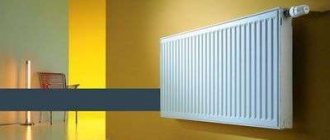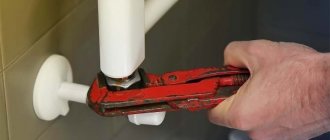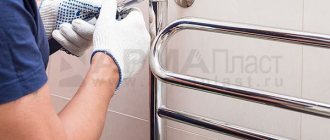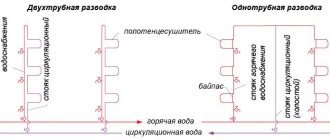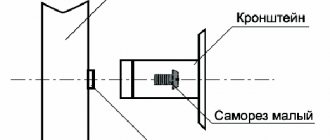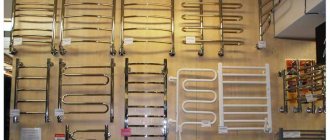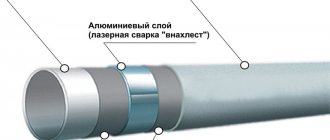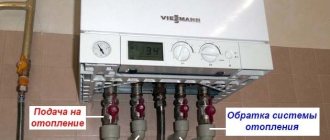- home
- Construction and renovation
- Plumbing
>
>
⬎
Many plumbers will agree that installing a water heated towel rail sometimes turns into a headache; it is the most problematic accessory in the bathroom. In this publication we will discuss a typical problem: a threaded connection, usually a detachable one, is leaking.
I would like to say right away that the main and main cause of leaks are chrome-plated connectors with union nuts. It is the union nuts paired with a poor-quality end of the heated towel rail pipe that causes the problem in the form of leaks.
Therefore, to minimize future mishaps, it is best to plan for chrome-plated connectors that only have a union nut on one side. It’s better, of course, to do without union nuts altogether (with the exception of the American cone), but for such an implementation, the range of stores is too limited, unfortunately.
It is better not to use such a decorative connector, a nut-nut (N-N): two union nuts increase the risk of leakage.
And this solution (nut-fitting or G-Sh) is already better: there is only one union nut.
However, the most reliable solution would be to use American cone connectors, which are packed onto the heated towel rail using linen or other materials. But as noted above, the choice of such fittings is usually small.
We will consider the choice of fittings for a heated towel rail in a separate topic, but now we will get out of the situation with what we have - with union nuts and flat gaskets.
Main leak locations
Many problems require you to contact a specialist. But knowing the locations of leaks and the reasons that led to them will help you repair the device yourself. Most often, a heated towel rail leaks at the junction of the main water supply pipe and the body of the dryer.
- If a leak occurs at the joint points under the union nut , the cause usually lies in the weakening of the mounting sleeve (American). It is appropriate to use a wrench to the size of the section or an adjustable one to tighten it along the thread (without overtightening, which is very harmful).
- The coil in the bathroom is leaking in the same place if the sealing gasket is leaking . Sometimes they install a part made of the wrong type of material, for example, installing rubber for a cold pipe on a hot dryer. The wrong diameter and material are used. Elements made of hard and semi-hard rubber, fluoroplastic, silicone and paronite are suitable.
A leak may appear at the welding points towel rail. In this case, a metal strip clamp will help to temporarily solve the problem. It is welded to the pipe.
Valera
The voice of the construction guru
Ask a Question
For sealing, use FUM tape, flax, tow, or place a professional gasket inside the nut. It is located at the end of the fitting, pressed against this part. When screwing the union nut onto another fitting, the second surface of the seal is also pressed against the other end. Water does not penetrate between the surface of the nut (inner) and the two mating fittings.
If you additionally wind tape or tow, the stainless union nut will not reach the end of the thread. The tightening force will remain the same, but the tightness will suffer, because the seal is not pressed between the ends of the bushings.
Prevention measures
Preventative measures do not require much effort, but can significantly save the dryer owner’s nerves.
- Once a year it is necessary to tighten the nuts at the points of connection to the network.
- Regardless of the presence of a leak, the gaskets need to be changed every 3-4 years. It is better to do this if there is no leak than to drown your neighbors during working hours when no one is in the apartment.
- When installing a heated towel rail, it is advisable to provide a bypass line to avoid problems with disconnecting the riser if a leak occurs.
Among heating engineers, a heated towel rail is considered a consumable item. It is not as expensive as a radiator to require unnecessary efforts to repair it. Therefore, in approximately half of the cases, the leakage problem is solved by simply replacing the device. But there’s no point wasting a day if you can fix the heated towel rail yourself. Therefore, it is better to completely replace the device only after other methods have not worked.
Causes of heated towel rail leaks
Consequences of water hammer
The operating mode of a water dryer is often disrupted. If the device operates from a central heating line, it serves for a certain period, and the rest of the time the surface is cold. The humidity in the bathroom is regularly high and there is a lot of steam in the atmosphere.
Causes of leaks:
- When working according to the standard regulations, there is no problem, because the drops that appear on the surface of the pipe dry out. When cold, condensation . Droplets cause corrosion if this phenomenon is repeated regularly.
- Destruction does not spare the pipes; the joints of the elements also rust . Old coils suffer, but new products can also leak due to rust.
- Damage to the integrity of the pipe and connectors from mechanical impact. For example, an impact when renovating a bathroom.
- The leak problem may be due to wear of elements , for example, rubber gaskets at the joints.
- The device parameters must match the characteristics of the system to which it is connected. This applies to the pressure in the DHW pipe. Sometimes the cause is water hammer if compensators are not installed.
- Installation in violation of technology , non-compliance with the rules of location, connection of the upper and lower pipes. The collectors may not be routed correctly, for example, the ends may be installed crookedly.
- Defect in production . Low-quality equipment is rare, but such models immediately refuse to work and leak water.
There are many reasons why a heated towel rail drips in the bathroom. An internal simple hexagon, poorly tightened, will cause trouble and expose leaks. The water coil may constantly leak, and the cause will be stray currents. Such phenomena occur more often in old high-rise buildings and cause accelerated development of rust.
They respond better to such “ladder” type drying currents. They have a system to prevent electrochemical corrosion and rust. Experts recommend grounding the coil.
Why do leaks occur after turning off the hot water?
After turning off the water supply in the pipes, the entire installation cools down. After using a shower or taking a bath, water vapor forms in the air. When heated moist air comes into contact with the cold surface of the coil, condensation appears on the surface.
Single drops of water connect, become heavier, and begin to flow onto the floor. A leak appears. In fact, the coil does not flow, it is drops of condensate falling . It is advisable to prevent this phenomenon, since drops have a harmful effect and violate the integrity of pipes and connecting sleeves.
Combat condensation by organizing effective ventilation . To do this, install a fan in the bathroom hood to increase air exchange. Steam is removed through the vent, and dry air enters through cracks in the doors or windows. If there is no forced ventilation, and the air does not escape naturally through the vent, leave the door open after each use of the shower.
Valera
The voice of the construction guru
Ask a Question
If, after turning off the hot water, the heated towel rail drips, for the summer, wrap the coil pipes with insulation, for example, padding polyester, batting, polystyrene foam, glass wool polyurethane foam. In this case, hot steam does not react with the cold surface, and condensation does not form. The store sells special insulation for pipes; you need to choose the right thickness.
Connection
The most important conditions for the correct connection of this equipment is the correspondence of the diameter of the riser and the device itself, without narrowing and, of course, high-quality fastening.
Let's look at the main and most common mistakes when installing a heated towel rail. First of all, it is not recommended to install shut-off valves, since closing them stops the circulation of water throughout the entire riser, which the neighbors will not be too happy about. That is why shut-off and control valves cannot be installed on risers. You can install a jumper to regulate the operation of the device and run hot water when needed without disturbing your neighbors.
When connecting a heated towel rail, you need to pay attention to the bypass, because a lot depends on it. First of all, it is needed to maintain a certain rate of water circulation. In addition, using a bypass, you can disconnect the towel dryer from the entire system without harming your neighbors
In addition, using a bypass, you can disconnect the towel dryer from the entire system without harming your neighbors.
Repair tools and materials
The set of tools depends on the type of dryer and the type of water pipes (metal-plastic, steel). You will need mounting brackets to secure the heated towel rail. Purchase sealing elements made of rubber or other material. If the device is an old type, you will need linen cloth, tow and lubricants for sealing. You need a heat-resistant sealant , sometimes cold welding.
Prepare the tools:
- an adjustable wrench or a set of open-end wrenches to fit the pipe cross-section;
- soldering iron, construction knife for cutting polypropylene pipes (if the line is made of the appropriate material), hammer, pliers.
The Americans are flowing.
#1 The Americans are flowing.
Message » March 31, 2011, 5:05 pm
Hello. I’m a guest on the forum and I’ll say right away that I’m quite far from plumbing and heating, BUT. I am an automotive engineer by training and have extensive experience working with cars. This is so, a lyrical digression so that you don’t consider me completely stupid))).
The question is actually the following: they installed a heated towel rail for us (I’ll make a reservation right away, here we missed a bit, since the person did not do it professionally, and now it’s difficult to ask him due to some other circumstances). They put it on American wheels, flat, with gaskets. The silicone ones, of course, were instantly pressed through; they were thrown out and made from good rubber. Such nonsense began as the towel becomes cold (but there is pressure in it) and begins to drip from it. the nut has to be tightened. I have already read that this is a disease of such American women. Now the question arises, what to do. A mechanic will do the work; the tiles cannot be broken (the pipes have been removed into the wall). I suggested to the mechanics that we make American conical ones, they seem to say the option is reasonable and has a place to be. So here's the actual question. If we install American cone valves, will the leak continue as it cools? Are they better than flat American women? AND WHO WILL ADVISE WHAT OTHER OPTIONS. THE TOWEL IS NOT FROM HOT WATER, BUT IT HAS IT'S OWN RISER, FROM HEATING, SO THE PRESSURE IS HIGHER THERE. Fifth floor. A 3/4 corner comes out of the wall onto the American piece, then an adapter (it can be removed if necessary to shorten it), then an American piece and a towel. I really hope for your understanding and qualified answers, thank you in advance))
Fixing leaks yourself
The repair method depends on the cause of the leak. Before work, close the shut-off valve at the entrance to the home. You can work with drying from the water supply for a whole year by turning off the tap. Coils that are connected to the heating system are repaired only in the summer after water is drained from the pipes.
Gasket wear
The layer of old paint is removed from the union nuts. To unscrew, use an adjustable wrench. The tool has adjustable jaws, so the cross-section is selected using a screw drive.
Further work order:
- Disassemble the threaded connection and remove the old gasket that has worn out. You cannot trim or straighten an old element with a knife or scissors in order to reuse it.
- An elastic part is placed between the ends of the pipes, and a union nut is screwed on top.
- Turn on the water supply to the heated towel rail and check the tightness of the connection.
If there is no factory element, take a piece of old thick rubber, put the old gasket as a pattern and cut it off after drawing the contours with a ballpoint pen.
The union nut is loose or missing altogether
There are times when the seal has recently been replaced, but the connection is still leaking. In this case, tighten the nut using an adjustable wrench. Make one turn, check for leaks, then add half a turn at a time. If you overtighten, you can damage the seal.
The procedure for installing a union nut if couplings are used and there is none:
- The depressions between the threaded turns are filled as much as possible with FUM tape or tow is placed on solid oil. It is not easy to determine the required volume of tape, so it is better to take flax or tow. If you wind a little, the liquid will flow out through the pipe, a large layer will lead to cutting when screwing, so it will flow again, it is better to wind in 1 - 2 layers.
- A part of the strand, thick according to the depth of the thread, is separated from the skein and twisted.
- Stepping back 5–6 cm from the edge, wind it clockwise around the edge, unroll it near the end and make a second winding counterclockwise.
- The remainder is wound from the center to the end at the end.
- The top of the tow is coated with sealant until completely saturated.
First, screw the coupling with your fingers, then tighten it with a wrench.
A rusty area or leak under a weld
Sometimes a through hole is found under the coupling due to corrosion. In this case, it is necessary to dismantle the coil and restore the damaged area by welding . It will be necessary to replace the damaged section or the entire dryer (depending on the size of the damage).
Under the influence of stray currents, pinpoint damage to the walls appears on heated towel rails that are not connected to the ground. If the leak is detected by small drops, deal with it yourself.
Operating procedure:
- Take wire to seal fistulas.
- Turn off the water in the dryer, sand the surface, and degrease it with an acetone solvent.
- Use a gas torch to heat the damaged area, press a wire against it, which melts and seals the hole.
- Excess material is immediately removed from the pipe without waiting for it to harden.
Valera
The voice of the construction guru
Ask a Question
If there is a leak at the welding site of the coil, you can install a clamp or use cold welding before the mechanic arrives. The temporary measure cannot be repeated indefinitely, so the heated towel rail is replaced with a new product.
Prevention measures
Preventative measures do not require much effort, but can significantly save the dryer owner’s nerves.
- Once a year it is necessary to tighten the nuts at the points of connection to the network.
- Regardless of the presence of a leak, the gaskets need to be changed every 3-4 years. It is better to do this if there is no leak than to drown your neighbors during working hours when no one is in the apartment.
- When installing a heated towel rail, it is advisable to provide a bypass line to avoid problems with disconnecting the riser if a leak occurs.
Among heating engineers, a heated towel rail is considered a consumable item. It is not as expensive as a radiator to require unnecessary efforts to repair it. Therefore, in approximately half of the cases, the leakage problem is solved by simply replacing the device. But there’s no point wasting a day if you can fix the heated towel rail yourself. Therefore, it is better to completely replace the device only after other methods have not worked.
Preventive measures
If the device is hung with an incorrect slope, it is leveled so as not to disturb the direction of the coolant flow. To improve water quality and reduce hardness, install a filter at the entrance to the bathroom . Be sure to arrange effective ventilation.
Electric heated towel rails are the best option, especially those running on oil. In principle, there cannot be any water leakage in them. They buy coils of any type only in trusted construction stores, choosing well-known brands.
Getting rid of corrosive changes
Long-term use of towel dryers is accompanied by the natural formation of rust. Corrosive changes affect not only the pipe elements of the device itself, but also their connections, which is caused by temperature changes and high humidity levels.
For the purpose of prevention, periodic checking of the device for the presence of rusty spots is used, which, under the influence of water hammer or increased pressure inside the water supply system, cause a strong breakthrough and an emergency situation. In this case, you will need to replace all rusted elements or install a new device
Of no small importance is the installation of hydraulic protection at the inlet group of the coil
Why does a heated towel rail rust and leak | Electrocorrosion protection
In April of this year, for the FIRST TIME IN BELARUS, mass production of “Lesenka” type heated towel rails with protection against electrocorrosion will begin!!!
Why is this topic so acute and relevant? In fact, consumers often ask questions about how to protect a heated towel rail from electrocorrosion . They are also concerned about topics such as:
- What is “electrocorrosion of a heated towel rail”, “stray currents”, or the more general term “electrochemical corrosion”?
- Why does a stainless steel heated towel rail still leak?
- Why don’t almost any manufacturers provide a guarantee if a heated towel rail leaks due to electrochemical corrosion?
- Is it even possible to protect a heated towel rail from stray currents?
Later in the article we will try to answer these questions in more detail.
Stainless steel heated towel rails
One of the popular materials from which heated towel rails are made is stainless steel, or “stainless steel”. The name suggests that this material does not rust.
The presence of oxygen in our tap water has always been the main cause of corrosion in black or galvanized steel heated towel rails. Indeed, a stainless steel heated towel rail is not subject to this type of corrosion for at least 10 years, provided that high-quality stainless steel, for example AISI 304, is used.
However, one circumstance is an exception - stray currents in the heated towel rail. They are the reason for the question “why is the heated towel rail leaking?” .
What are stray currents in a heated towel rail?
The nature of the occurrence of currents in tap water is still not fully understood. And therefore it is difficult to find methods to combat this phenomenon. At the moment, all manufacturers of heated towel rails recommend grounding as a way to solve this problem.
For example, there may be such a case: a neighbor on the riser grounds a faulty household appliance (most often an old washing machine) to the water supply pipes. Thus, the currents spread through the pipes, and since the heated towel rail is supplied with polymer pipes (i.e., the pipe material is dielectric), the current passes into the water, and a process begins that leads to the heated towel rail rusting from the inside.
As a result, spots with signs of corrosion appear on the heated towel rail. The number of these points increases over time, and the original points increase in diameter, and you can already notice a slight leak of water through them. The process of electrochemical corrosion has begun. Here is the answer to the question why the heated towel rail is leaking.
In the case described above, grounding will help save your heated towel rail.
To do this you need:
- Make potential equalization: connect the metal parts of the riser together with copper wire. The places where the wires are attached to the pipes must first be cleared of paint.
- For reliability, ground the metal riser itself. You need to connect the copper wire from the riser to the PE bus of the nearest floor electrical panel. First you need to make sure that the grounding on the electrical panel is working.
However, the case described with an old washing machine does not happen often in practice. Much more often, products deteriorate due to other reasons that cause electrocorrosion of stainless steel. And the grounding installation is no longer able to provide complete protection for the heated towel rail.
Currents can even arise in the device itself. For example, in hard water simply due to the contact of incompatible materials: for example, a brass coupling with a steel body of a heated towel rail.
The reasons why a heated towel rail can corrode can be different. However, the consumer is interested not so much in the reasons that cause rusting of the device, but in protecting the heated towel rail from electrocorrosion.
In Belarus, the question is often asked: the heated towel rail is leaking, what to do about this problem? The problem is especially acute in cities with hard tap water with a high presence of salts and chloride compounds.
Such cities include Soligorsk and Mikashevichi. This problem is partially relevant for Baranovichi, Luninets, Vitebsk, Gomel and Minsk.
Electrocorrosion protection
To solve the problem, our engineer and technologist developed a special protection for the heated towel rail. Thanks to it, the service life of the product in cities with hard water is extended three times when compared with a stainless steel product without this protection. And provided that grounding is installed and brass fittings are not used when connecting the heated towel rail, the service life will further increase significantly.
It must be said that this protection is installed only in products of the “Ladder” type, and M- and MP-shaped heated towel rails are produced without protection against electrochemical corrosion.
We offer reliable heated towel rails of the “Ladder” type with protection against electrocorrosion. They will be relevant both for residents of Belarus and for other countries where the same problem exists:
- Kazakhstan (Astana and most cities in central and northern Kazakhstan).
- Russia (Moscow, Chelyabinsk region, Kaliningrad region, Primorsky Krai and a number of other regions and cities), etc.
We are ready to provide these cities and regions with our heated towel rails with protection against electrochemical corrosion. For ease of settlements, companies in Russia do not need to work directly with Belarus.
Signing contracts, issuing documents and all payments will be carried out through a Russian company. Transport costs, as a rule, do not exceed 5% of the cost of the product.
Shipment of heated towel rails is carried out to the Russian Federation through transport and fuel and energy complex “Transaviatur”...
We are waiting for your orders!
Source: https://glossreiter.by/elektrokorroziya-polotencesushitelya/
conclusions
To avoid leaks, as well as frequent breakdowns of the heated towel rail, it is necessary to handle repair work responsibly. If you don’t know how to cope with a particular task, there is no need to improvise; it is better to invite a specialist who will tell you how to cope with this or that task. When a professional does the work, the risk of leakage is significantly reduced, and heated towel rails serve their owners for a very long time.
We wish you that your heated towel rails rarely fail, and that the breakdowns are completely insignificant.
